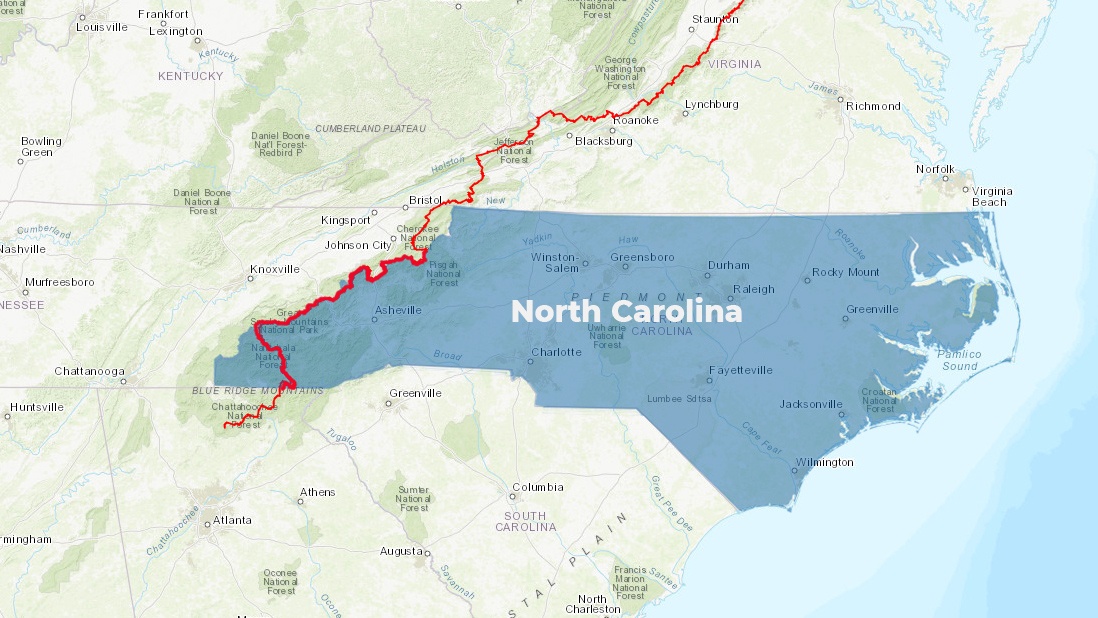A.T. Miles in State
A.T. Miles NC/TN Border
1-7
Easy to Challenging
Elevation Range in Feet
 The North Carolina section of the A.T. rises to spectacular summits — including the 6,643-foot Kuwohi, formerly called Clingmans Dome, the highest mountain on the A.T. — and drops down along the lush banks of the Nantahala River.
The North Carolina section of the A.T. rises to spectacular summits — including the 6,643-foot Kuwohi, formerly called Clingmans Dome, the highest mountain on the A.T. — and drops down along the lush banks of the Nantahala River.
There are approximately 96 miles of the A.T. in North Carolina, but the Trail runs along the Tennessee/North Carolina border for approximately 220 additional miles. As the A.T. ascends to the High Country of the state line, hikers traverse the highest mountains along the Trail, including several above 6,000 feet.
The section of the A.T. along the North Carolina-Tennessee border north of Great Smoky Mountains National Park sustained severe damage in fall of 2024 from Hurricane Helene. Learn about current conditions, closures, and important safety information before heading out to the Trail in this section.
For backpacking in the Smokies, you’ll need an advance permit for Great Smoky Mountains National Park, and depending on the length of your hike, shelter reservations as well. All backpackers are required to stay at designated sites.
 Carolina Mountain Club(CMC)
Carolina Mountain Club(CMC)The Carolina Mountain Club (CMC), the oldest Hiking and Trail Maintaining Club in Western N.C., fosters the enjoyment of the mountains of Western North Carolina and adjoining regions. CMC maintains 92.6 miles of the Appalachian Trail from Davenport Gap to Spivey Gap.
 Nantahala Hiking Club (NHC)
Nantahala Hiking Club (NHC)The Nantahala Hiking Club (NHC) is one of 31 volunteer Appalachian Trail (AT) maintaining clubs of the Appalachian Trail Conservancy (ATC). The NHC maintains 58.6 miles of the AT from Bly Gap at the Georgia/North Carolina border to the Nantahala Outdoor Center on the Nantahala River at Wesser, NC. The club also maintains several trails that connect to the AT.
 Smoky Mountain Hiking Club
Smoky Mountain Hiking ClubThe Smoky Mountains Hiking Club, founded in 1924, is one of the oldest and largest hiking clubs in the southeastern United States. The SMHC has a long tradition of hiking, fellowship, volunteerism, and conservation, following in the footsteps of our famed and influential early leaders Harvey Broome, Carlos Campbell, Jim Thompson, Dutch Roth, and many others. Learn more and become a member today by clicking here.

The Appalachian Trail Conservancy is always looking for dedicated volunteers to help maintain the A.T. and assist in our visitor center and headquarters. Opportunities range from greeting visitors and providing information about local hikes to joining a Trail crew for week-long maintenance trips, gaining first-hand experience in what it takes to keep the A.T. open and enjoyable for millions each year. Learn more at appalachiantrail.org/volunteer.
The iconic bald mountains along the Appalachian Trail in North Carolina and Tennessee are significant to the future of migratory and resident birds.
These hikes are not only enjoyable, but also safe for a colder day
Wide-open vistas beyond the footpath offer respite and are essential to the Wild East.




